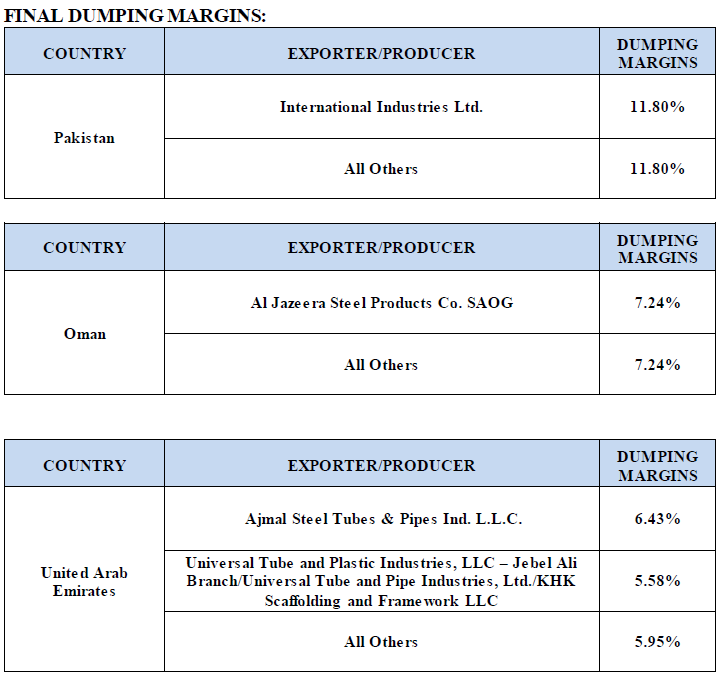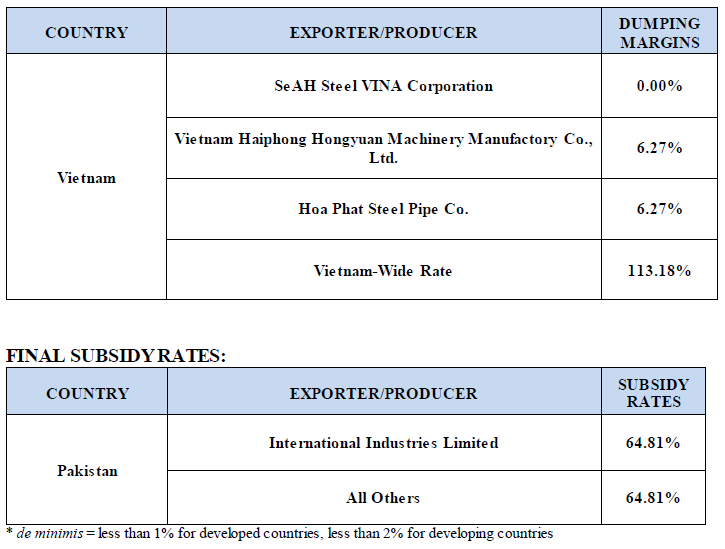Trade Cases

Commerce Finds Dumping of Circular Welded Steel Pipe
Written by Sandy Williams
October 24, 2016
On Monday, the U.S. Department of Commerce (Commerce) announced its affirmative final determinations in the antidumping investigations of imports of circular welded carbon-quality steel pipe from Pakistan, Oman, the United Arab Emirates, and Vietnam, and the countervailing investigation of imports of the same merchandise from Pakistan.
The investigations cover welded carbon-quality steel pipe and tube, of circular cross-section, with an outside diameter not more than 16 inches, regardless of wall thickness, surface finish, end finish, or industry specification. The products are generally known as standard pipe, fence pipe and tube, sprinkler pipe, and structural pipe and are intended for the low-pressure conveyance of water, steam, natural gas, air and other liquids and gases in plumbing and heating systems, air conditioning units, and automatic sprinkler systems. The products may also be used for light load-bearing and mechanical applications, such as for fence tubing.
Commerce determined that imports of circular welded carbon-quality steel pipe from Pakistan, Oman, the United Arab Emirates, and Vietnam have been sold in the United States at dumping margins of 11.80 percent, 7.24 percent, 5.58 percent to 6.43 percent, and 0.00 percent to 113.18 percent, respectively. Commerce also determined that imports of circular welded carbon-quality steel pipe from Pakistan received countervailable subsidies of 64.81 percent.
The petitioners for these investigations are Bull Moose Tube Company (Chesterfield, MO), EXLTUBE (N. Kansas City, MO), Wheatland Tube Company (Chicago, IL), and Western Tube & Conduit (Long Beach, CA).
Next Steps: The U.S. International Trade Commission will make its final determination regarding injury on December. 5. If the ITC finds in the affirmative, orders will be issued in the AD/CVD cases on December 12.

Sandy Williams
Read more from Sandy WilliamsLatest in Trade Cases

Tariff fallout: Canada strikes back, Stellantis idles, GM boosts production
Canada imposes auto tariffs, while automaker Stellantis temporarily idles some plants.

Commerce tags UAE with ‘critical circumstances’ in CORE trade case, South Africa spared
The Commerce Department has made a preliminary determination that ‘critical circumstances’ exist for certain imports of corrosion-resistant (CORE) flat-rolled steel from the United Arab Emirates (UAE). Commerce decided that critical circumstances did not apply to CORE from South Africa. The department also found that critical circumstances did not apply to CORE from UAE producers Al-Ghurair Iron & Steel LLC and United Iron & Steel Company LLC.

Trump’s ‘Liberation Day’ brings 10% baseline tariffs; steel, aluminum, and autos/parts excluded
President Trump’s promised “Liberation Day” has arrived, with a 10% minimum tariff on imports. But there are some very important exceptions: The United States’ USMCA partners, Canada and Mexico, are excluded from the reciprocal tariffs for now. In addition, steel, aluminum, as well as autos and auto parts are excluded from the reciprocal tariffs. That’s […]

Price on Trade: Auto tariffs, auto parts, and Hyundai – a world of rapid changes
Trump's new auto tariffs will apply to passenger vehicles (including sedans, sport utility vehicles, crossover utility vehicles, minivans, and cargo vans), light trucks, and certain automobile parts (including engines and engine parts, transmissions and powertrain parts, and electrical components).

CRU: Canacero urges Mexico-US partnership to fend off Asian steel imports
Victor Cairo, head of Mexico’s steel sector body Canacero and CEO of ArcelorMittal Mexico, says he is confident negotiations between the Mexican and US governments planned for April 2 will lead to the creation of a regional block to substitute imports, especially from Asia.


